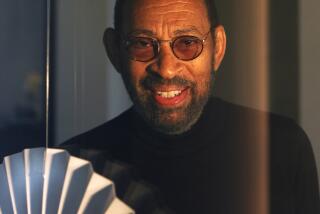‘Stormy Weather’ Forecast Tonight for Downtown Theater
- Share via
Fred Astaire called it the greatest dance number he had ever seen on film. Any movie musical buff will recognize it immediately. Nearly half a century after it was shot, audiences still shake their heads and clap their hands.
It’s the dance routine performed by the Nicholas Brothers in 20th Century Fox’s “Stormy Weather,” an all-black musical featuring Bill (Bojangles) Robinson, Lena Horne and a supporting cast that reads like a Who’s Who of black stars.
The sequence begins with the Nicholas Brothers’ trademark array of spins and splits, danced atop tables, drums, a piano and a plain old stage. Then a curtain opens to reveal a huge white staircase, which the pair scale, proceed to descend in a series of crashing leaps and splits, one over the other, only to climb back up again for a climactic slide down a ramp in split position.
As part of its classic cinema showcase, “The Last Remaining Seats: From Balconies to Back Seats,” the Los Angeles Conservancy is presenting “Stormy Weather” tonight at the Los Angeles Theater, 615 S. Broadway.
The program will also include the Tex Avery cartoon “Swing Shift Cinderella,” a live performance by the Chester Whitmore Dancers and a special appearance by Fayard Nicholas.
Fayard and his younger brother, Harold, began dancing as children in a Philadelphia burlesque house, but soon found themselves headlining at Harlem’s Cotton Club during its heyday in the ‘30s.
As one of that era’s “flash acts,” the Nicholas Brothers made lightning strikes in numerous Hollywood musicals of the ‘30s and ‘40s. Limited often to scarcely more than five minutes’ screen time, they elicited ovations in movie houses around the world with their blend of acrobatics and classical tap. And it is arguably the staircase routine in “Stormy Weather” for which the Nicholas Brothers are best remembered.
“I didn’t realize it was going to be so famous,” says Fayard Nicholas, speaking in the library of the Motion Picture Country House where he resides with his wife, Barbara.
“That was one take, coming down those stairs (and) jumping over each other’s heads,” says Fayard, 73.
At the time “Stormy Weather” was being made, the Nicholas Brothers were at the peak of their Hollywood career. They had made their first film, “Kid Millions,” in 1934; in 1940, they signed on for seven years with Fox.
Their last Hollywood musical was Cole Porter’s “The Pirate” (1948), in which they finally worked with Gene Kelly. Their acrobatic routine with Kelly in the number “Be a Clown” became one of the highlights of the movie.
Fayard doesn’t leap tall staircases in a single bound as he once did, but neither does he rest comfortably on his laurels. After undergoing hip-replacement surgery several years ago, he resumed performing.
“I’m supposed to be retired,” Fayard says, smiling. Earlier this year, he traveled to Amsterdam to dance at a jazz festival. In June he flew to New York to collect a Tony Award for his choreographic work on the Broadway hit “Black and Blue.” Next month, he will join his brother for a stint at a club in the Bay Area, and then they will fly to Britain for a benefit.
Harold, meanwhile, is based in New York and still keeps dancing.
In the movie “Tap,” starring Gregory Hines and Sammy Davis Jr., he pulled off a few of the patented Nicholas Brothers splits. He has just completed a San Diego production of “My One and Only.” In September Nicholas will return to Los Angeles to rehearse “Sophisticated Ladies.” Back in 1982, he replaced Gregory Hines in the same show at the Shubert Theatre.
When they perform together these days, the Nicholas Brothers combine dance with other forms of entertainment.
“Now what we do, we show our film clips,” says Fayard Nicholas.
“Usually we’ll show ‘Stormy Weather’ right before we come on, and then the two of us come out together and we’ll go right to the microphone and start talking--we don’t dance right away.”
First they have to wait for the applause to die down.
“When we come on stage after they show it, if there are 3,000 people in the theater, all 3,000 stand up at the same time and start going”--Nicholas claps his hands together several times.
“That’s a great feeling.”
More to Read
The biggest entertainment stories
Get our big stories about Hollywood, film, television, music, arts, culture and more right in your inbox as soon as they publish.
You may occasionally receive promotional content from the Los Angeles Times.










